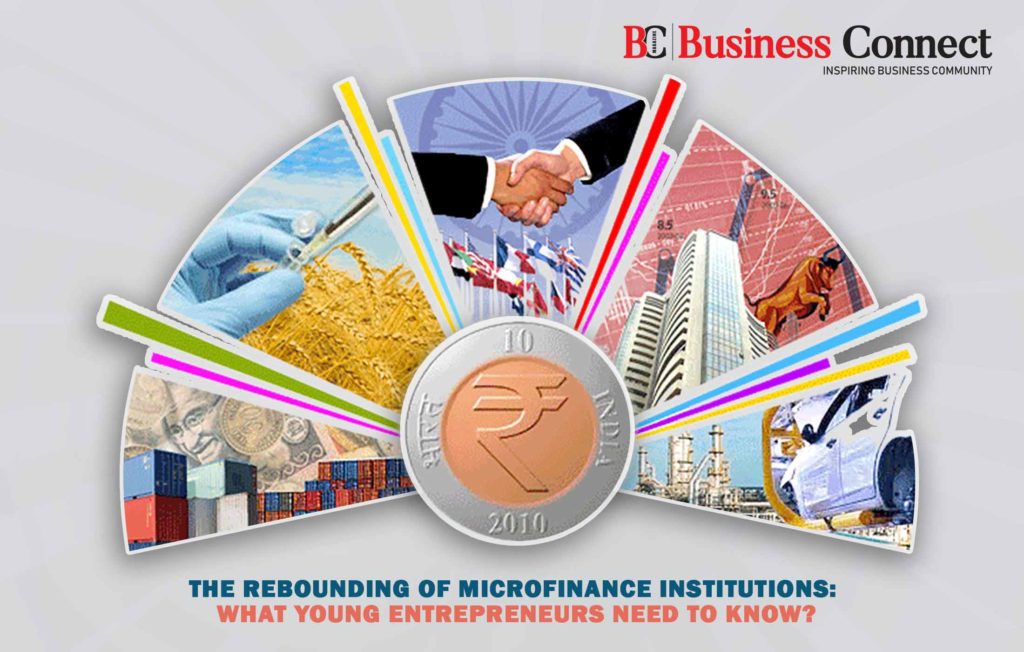Written by: Dr. Amit Mishra
The Rebounding of Microfinance Institutions: What Young Entrepreneurs need to Know?
- The ultimate objective of microfinance is to enhance easy accessibility, cost-effective and sustainable financial services or microloans to the budding entrepreneurs, unemployed youths, low earning individuals, a financially poor section of the society, or micro or small enterprises, resulting in raising their incomes or establishment of a profitable business.
- According to the Global MPI report 2018, India has made remarkable progress by drastically reducing its poverty rate from 55% to 28% in the last 10 years.
With the recent declaration of new ventures in different Start-up sectors, to set up the sustainable entrepreneurship ecosystem driven by government’s financial inclusion agenda, the microfinance in India, with substantial opportunities, is emerging strongly and making a comeback after facing the challenges of demonetization. Sustainable rural development can be attained by focussing on microfinance because of its supportive and self-employment role. The overall GLP (Gross loan portfolio) of micro-finance is expected to increase at a CAGR of 28% in 2022.
In recent years, the era changer step taken by Prime Minister Narendra Modi towards e-government with a tag line “we move with the dream of electronic digital India….”, with an aim to “Transform India into digitally empowered society and knowledge economy”, has come up with e-Shakti (Apps also available) or digitisation of SHGs (Self Help Groups), an initiative of Micro Credit and Innovations Department of NABARD, and Digital India, to integrate the government departments, the people of the country (including villagers and farmers) and to ensure effective governance. Altogether these steps have supported the concept of microfinance companies to raise funds, understanding the tremendous potential of the concept in eradicating poverty in developing nations.
Entrepreneurs can’t take off in the absence of necessary funding. To dream of solving problems with innovations is good, but the ground realities need to be taken into consideration in this successful entrepreneurship journey. To face the financial burden along with the cut-throat competition of the business world is the usual problem faced in Start-ups businesses. Usually, most people have no or limited access to public financial services.
However, the obvious question arises is “How to resolve the financial part of Start-ups?”
Monitoring the financial situation of clients and educating borrowers about better money management gives micro-finance system an upper hand to the traditional loan offered by the banks. SIDBI (Small Industries Development Bank in India), HDFC Bank, Reliance, ICICI Bank, SBI Bank, etc. are the leading formal sector microfinance providers in India.
What is microfinance?
Microfinance offers financial and non-financial services to the budding entrepreneurs, (especially women) and men, including self-employed who are not accessible to the traditional banking system. A microfinance bank (or microfinance institute) is the organization which offers such services, it can be a credit union, commercial bank, financial NGOs, or a credit cooperative.
Microfinance includes microcredit or microloan, “micro” means “small in scale”, the provision of small loans to underprivileged clients who have innovative business ideas but are not in a financial situation to execute the Start-up venture.
The long history of indigenous banking and money lending dates back to Vedic times, around 2000 to 1400 B.C. Currently, there are three models prevalent in Indian microfinance sector-(1) JLG (Joint Liability Group) (2) SHG (Self Help Group) (3) SHG Bank Linkage
Microfinance services are programmed in order
- To generate sustainable activities to enhance income
- To lessen external business upsets
- To raise the living conditions of entrepreneurs and their families
- To empower Budding Entrepreneurs and Women
What are microfinance banks?
Microfinance institutions or banks are playing a significant role in women empowerment in India. By offering financial services to the underprivileged women or men of the country, these institutions have opened the door for thousands of young women or men who are looking for their economic growth. Uneducated, poor and unemployed women or men usually face lots of issues to access loans from traditional lending organizations and this is where the microfinance banks have come to their rescue.
They provide women or men access to finance services and offer them easy loans, savings accounts, insurance, and several others as per their eligibility and requirement. Maharastra and Bihar have the largest number of microfinance institutions operating under the JLG or SHG hybrid model.
Salient points of microfinance
- Creditors are from the low-income section
- Loans comprise small amount – micro-credits or microloans
- Loans are for Short duration
- Loans given are without security or guarantee
- Frequency of repayment is high
- Loans are usually considered for income generation purpose
India is currently one of the most promising markets for microfinance in the world, by successfully running Microfinance institutions in lots, and having an outstanding market potential in the Microfinance Industry. An enormous number of the government and non-governmental organizations (NGOs) are running several projects to uplift the life of the unbanked and underbanked section with a significantly high success rate.
Recent upsurge seen in the Start-up micro-finance industry has given a green signal towards sustainable growth, with the expectation to create a miraculous impact by the union of Machine learning and Artificial Intelligence, to be the key driver in the Next generation sustainable micro-finance distribution model.



